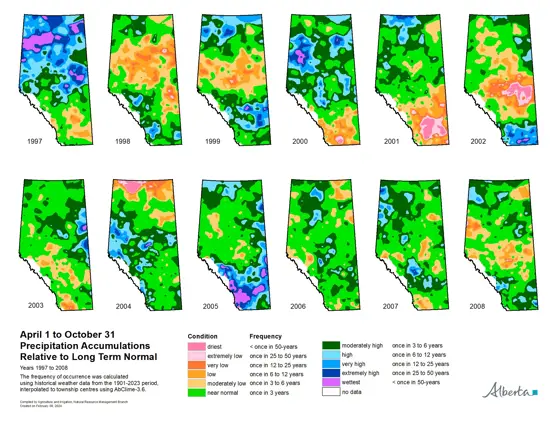Moisture Update - May 8, 2024
Synopsis
Maps 1, 2 & 3: Since May 2, 2024, another major storm system brought significant rains across much of the east-half of the province, ranging from more than 100 mm in the Cypress Hills area, to 30- 70 mm through parts of the Central Region, and 20 to 40 mm across the agricultural lands in the North East Region (Map 1). In sharp contrast, most of the Peace Region received very little moisture, a condition that has been ongoing for several months.
Recent rains combined with a large storm system that arrived during the last days of April, brings the 30-day precipitation accumulations to well over 40 mm across most of the South, Central, and North East regions, with large areas within these regions receiving well over 60 mm (Map 2). In contrast, much of the Peace Region and parts of the western portions of the North West Region received less than 20 mm, with some areas in the Peace Region receiving less than 10 mm.
Precipitation over the last 30-days has been at least near normal across most of our agricultural lands, with parts of the North West and Central Peace Region remaining dry and suffering from once in 3 to 12 year lows (Map 3). Drought stricken areas across the eastern half of the province are mostly trending to once in 6 to 12 year highs, with some areas seeing it this wet on average less than once every 50-years. Most of the precipitation fell over several days and had the opportunity to soak deep into the soil, which marks a great start to the growing season.
180-Day Precipitation Trends
Maps 4 & 5: Looking back over the past 180 days, despite the recent ample rains in some areas, many parts of the province lying north of the Yellowhead highway, are still well below normal, with a large area in the central Peace Region trending to less than once in 50-year lows (Map 4). Here, pastures will need moisture very soon, as the weather turns warmer. With a complete lack of meaningful, winter snow packs in many areas, parts of the Central Peace Region have received less than 30 mm since November 11, 2023. Normal ranges from 100 to 120 mm. It is now imperative that the May rains arrive on time (Map 5).
Soil Moisture Reserves
Maps 6, 7 & 8: For most of the province south of the Peace Region, soil moisture reserves have rebounded significantly over the past month (Map 6). Across the Southern Region and the previously parched lands of the Special Areas, soil moisture is now above normal in many fields, and is up to once in 12 to 25 year highs across parts. Relatively dry areas west of Highway 2, between Edmonton and Calgary, are evident, but this part of the province is typically wetter at this time of year and, as such, it is estimated that there is currently 100 mm of water in 120 cm depth of soil ready to support early growth (Map 7). In sharp contrast, across the Peace Region there is less than 60 mm of moisture contained in a typical soil profile, which for this time of year is estimated to occur less than once in 12 years, with several pockets trending to less than once in 50 year lows (Map 6). Most of these lands will need at least 50-75 mm of precipitation to bring soil moisture reserves to near normal for this time of year (Map 8).

Perspective
Map 9: Despite very dry conditions across the Peace Region, there is still time to receive moisture for seeded crops as the wet season in this area historically begins around the May long weekend and persists well into August. However, pastures are struggling and will need moisture very soon. If they have not been over-grazed, it is expected that they will respond rapidly to meaningful and timely rains as the weather warms and hopefully turns wetter in the coming days.
Excess soil moisture is likely building across parts of the Southern Region and local surface depressions are being filled with water, reducing the land's ability to further absorb heavy rains. May and June are the wettest months of the year here and if one or two more major systems bring in excessive rainfall, flooding or soggy fields may become a concern, particularly in poorly drained areas. This is a complete reversal to the problems faced in 2023, and should serve as a reminder that conditions often change rapidly in Alberta. This abrupt reversal is not in any way 'unprecedented' as there are many examples of this in the meteorological record, which can be explored using the many maps, and data products available on the Alberta Climate Information Service. For southern Alberta, 2002 is one recent example where excessive moisture in the summer followed a severe drought, that began in 2000 and peaked in 2001 (Map 9). Similarly, across the Peace Region dry conditions prevailed in 1998 and 1999, with wet weather arriving closely on its heels in 2000.
Contact Us
Saddle Hills
Junction of Hwy 49 & Secondary Hwy 725
RR1, Spirit River AB
T0H 3G0
T. 780-864-3760
Fax 780-864-3904
Toll-free 1-888-864-3760
frontdesk@saddlehills.ab.ca
Sign up to our Newsletter
Stay up to date on the Saddle Hills activities, events, programs and operations by subscribing to our eNewsletters.








